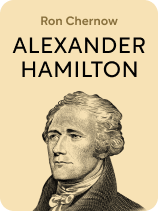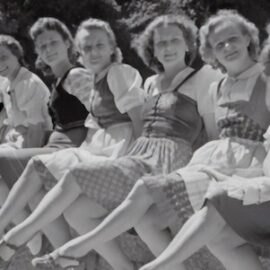

This article is an excerpt from the Shortform book guide to "Alexander Hamilton" by Ron Chernow. Shortform has the world's best summaries and analyses of books you should be reading.
Like this article? Sign up for a free trial here.
Why is Alexander Hamilton considered one of the most important figures in United States history? What role did Hamelton play in establishing US capitalism?
Ron Chernow’s biography of Alexander Hamilton considers the Founding Father’s life and legacy, including his unlikely ascension from a poor student to a trusted advisor of George Washington. Chernow also covers how the events of Hamilton’s life have influenced American history.
Read below for a brief overview of Alexander Hamilton’s biography.
Alexander Hamilton by Ron Chernow
In this comprehensive Alexander Hamilton biography, journalist Ron Chernow argues that Hamilton has been significantly overlooked compared to the other Founding Fathers. While Hamilton never served as president, he was hugely influential in designing the structure of the federal government and the US economy. Though Hamilton had fallen out of political favor by the time he died in 1804, his prolific writings on law and the US Constitution are still cited to this day. Ultimately, Chernow believes that America today fulfills Hamilton’s vision more so than the visions of his political rivals, particularly Thomas Jefferson.
(Shortform note: Ironically, the success of Chernow’s book means that as of the 2020s, his central premise—that Hamilton has been overlooked by history—is no longer true. In 2015, the biography was adapted into the hit Broadway musical Hamilton, which made over a billion dollars in global revenue and won dozens of awards, including the 2016 Pulitzer Prize for Drama. Chernow’s biography, originally published in 2004, became a bestseller for the second time. Today, Hamilton is perhaps the best-known Founding Father after Washington and Jefferson.)
This overview is split into six sections:
- Hamilton’s Early Life will cover Hamilton’s childhood and participation in the revolutionary movement
- The Revolutionary War and Service with Washington will discuss how Hamilton gained influence as Washington’s aide-de-camp
- Post-War Restructuring will consider Hamilton’s involvement in the writing of the Constitution and its ratification
- Hamilton as Treasury Secretary will cover his work in the White House
- Federalism Versus Republicanism will discuss the formation of political parties and the rivalry with Jefferson that defined Hamilton’s career
- Hamilton’s Death and Legacy will recount his fatal duel with Aaron Burr and how Hamilton was remembered
(Shortform note: Chernow’s book received near-universal acclaim, as did his biographies of J. P. Morgan, John D. Rockefeller, and George Washington, the last of which won the 2011 Pulitzer Prize. He has often described Alexander Hamilton as a bridge between his earlier works on American financial giants and his later work on the Founding Fathers. The book has been praised for thoroughly arguing that Hamilton’s influence has been overlooked by historians, but it has also been criticized as being too sympathetic to its subject.)
Hamilton’s Early Life
Throughout the biography, Chernow emphasizes that Hamilton was something of an outsider among the Founding Fathers (the revolutionary leaders who founded the United States) who nonetheless made essential contributions to the formation of the new country. While most Founding Fathers came from aristocratic backgrounds, Hamilton was born to a poor family around 1757 and was raised on the islands of St. Kitts, Nevis, and St. Croix in the Caribbean. The exact details of Hamilton’s parentage have been debated by scholars, and throughout his life he was mocked for being illegitimate (his parents were never officially married) and possibly mixed-race, though Chernow dismisses the latter claim.
Hamilton found early success as a writer for his local newspaper, and around 1772 he left for the American mainland to pursue an education. He attended college in New York, receiving what Chernow calls the traditional education of a gentleman, which emphasized rhetoric, literature, philosophy, and politics. At this time, Hamilton was exposed to the burgeoning American revolutionary movement and began writing and speaking publicly in support of anti-British action, such as the Boston Tea Party of 1773, in which a band of revolutionaries destroyed tea imports from England to protest oppressive new taxes.
In 1774, revolutionaries formed the First Continental Congress, in which representatives from twelve out of the thirteen American colonies gathered to share their grievances against British rule, write a petition requesting better treatment, and declare a boycott of British goods. Pro-Britain critics called the Congress treasonous and insisted that the colonies had no hope of winning a fight against Britain.
Hamilton responded by writing two pamphlets in which he argued that Britain had repeatedly violated the rights of American colonists and denied them the opportunity to legally advocate for themselves. Forming the Congress was the next logical step, a moral necessity for those who believed in justice, and not necessarily a precursor to violence, though Hamilton argued that victory was possible if it came to that. Chernow states that the pamphlets were widely read and admired for their clear argumentation and thorough analysis of British and colonial law.
The Revolutionary War and Service With Washington
War finally broke out between Great Britain and American revolutionaries in the spring of 1775, and Hamilton dropped out of school to join his local volunteer militia. While Hamilton served in several battles, Chernow argues that the most significant event of the war for Hamilton would be his appointment to the staff of General George Washington in 1777. Washington was Commander in Chief of the entire Revolutionary Army and would become the first president of the United States in 1789. His lifelong friendship with Hamilton made the latter’s political career possible, as Hamilton went from being a poor little-known writer to the trusted advisor to the most powerful man in the country.
Chernow argues that Washington placed enormous faith in Hamilton, using him not just as a scribe and courier but allowing him to write letters on Washington’s behalf and deliver orders in Washington’s name. When France joined the war on the side of the revolutionaries in 1778, Hamilton acted as Washington’s interpreter, making him even more essential. While the two men had a falling out in 1781, which Chernow believes was over Hamilton’s desire for a military command of his own, they would renew their friendship by the end of the decade. The war also made Hamilton increasingly famous and admired among revolutionaries, as he participated in decisive victories over the British such as the battle of Yorktown.
Post-War Restructuring
Having won the war by 1783, the newly independent American government was faced with the problem of developing a functional government in the face of bankruptcy and political unrest. Chernow argues that it was at this time that Hamilton became a significant political figure, most notably as a delegate to the 1787 Constitutional Convention and the primary author of The Federalist Papers, a series of essays defending and explaining the Constitution to the general public.
Though Hamilton did not write the Constitution—Virginia delegate James Madison was its primary author—the final document largely conformed to his vision of what the US government should look like in the coming decades. This meant a strong, centralized power with the authority to unite the entire American population, which at that time was divided into 13 semi-autonomous states.
Hamilton as Treasury Secretary
After the Constitution was ratified by a majority of the states, politicians began formally organizing the government, and in 1789 Washington was elected the first president of the US. Chernow argues that Washington was the only possible choice for the job by the turbulent 1780s, since he commanded near-universal respect after leading the Revolutionary Army to victory. Washington appointed a cabinet of ministers to assist him in decision-making, including Hamilton as the first Secretary of the Treasury. This was the highest office Hamilton would ever hold, and Chernow claims that Hamilton left a permanent mark on the US economy, driving it toward capitalism, industrialization, and trade.
Federalism Versus Republicanism
While serving as Treasury Secretary, Hamilton also became an important figure in the emergence of the first American political parties, which had begun to develop during the Constitutional ratification process and became powerful forces under the Washington administration. They were not formal organizations, but loose alliances of politicians who shared beliefs about the US economy, foreign relations, the future of slavery, and so on. Loyalty tended to consolidate around powerful figures, and Chernow argues that Hamilton and Jefferson were the unofficial heads of the Federalist and Republican parties, respectively. Both men dominated American politics even after they each left their positions in Washington’s cabinet.
The development of political parties was initially viewed with alarm by many, as they were seen as a threat to cooperation in government and a vestige of the monarchy, in which factions competed for the king or queen’s favor. As a result, party activity such as selecting presidential candidates to represent the larger group’s interests was generally done behind the scenes. In his 1796 farewell address, Washington disavowed “factionalism” and asked that politicians seek unity over infighting, to little effect. The press recognized and wrote about party allegiances, and several pro-Federalist and pro-Republican newspapers were funded by Hamilton and Jefferson to drum up public support for their causes.
North Versus South and the Slavery Question
Chernow notes that most Federalists came from northern states, while most Republicans came from southern states. This was reflected in the parties’ contrasting beliefs about the future of the US economy. The North was increasingly urban and dependent on manufacturing, and while slavery was still practiced in states like New York and New Jersey, slaves were a small portion of the population and mostly worked in domestic household positions. By contrast, in southern states like Virginia and South Carolina, the economy depended on the production of cash crops like sugar, cotton, and tobacco on massive slave plantations, and slaves made up close to half of the total population.
Chernow describes Hamilton as a committed abolitionist who worked with the New York Manumission Society to defend slaves and free African-Americans in court. While not all Federalists opposed slavery outright, many favored scaling back the practice alongside a push toward greater industrialization to create a domestic market for American raw materials. Republicans, on the other hand, largely saw slavery as essential to the American way of life and condemned the push for abolition as an attempt by Federalists to break down Republican power and deprive southern voters of economic influence. Several fights against slavery were waged in Congress in the last years of the 18th century, but all failed.
Friendship With Britain Versus With France
France’s democratic revolution in 1789 and subsequent war with much of Europe, including Britain, would become a flashpoint in the struggle between Federalists and Republicans. The two parties disagreed about whether to maintain neutrality in the conflict and which country—Britain or France—could prove to be a better ally to the US in the coming decades. Though both Jefferson and Hamilton had left office by 1794, they continued to exert influence in Congress and the cabinet of the US’s second president, the Federalist John Adams.
The Federalists favored a renewed friendship with Britain, seeing it as a more stable and economically valuable partner. Hamilton in particular advocated for increased trade between the US and Britain. By contrast, Republicans saw the French Revolution as the ideological companion to the American Revolution, fought against a monarchy on the same principles of democracy and freedom. Jefferson and others also argued that the US owed France for its assistance during the Revolutionary War.
The Slow Collapse of Federalism
By the end of the 18th century, Federalism’s popularity was waning. Chernow argues that the party lost all significance under a succession of Republican presidents, beginning with Jefferson’s election in 1800. Though Federalism continued operating for another decade, it had few voters outside of New England. Chernow attributes the party’s collapse to infighting, a series of unpopular measures implemented by Adams, and Hamilton’s own diminishing influence as he was beset by scandal and increasingly out of step with the party line.
Hamilton’s Death and Legacy
Chernow argues that Hamilton’s death in a duel with politician Aaron Burr would be his most famous misstep, overshadowing accounts of his life up until the modern day. This is partly due to the sensationalism of the crime, as both Hamilton and Burr were famous public figures, dueling had recently been outlawed in New York, and Hamilton was relatively young (47) at the time of his death.
Duel With Burr
Burr was a frequent target of Hamilton’s criticism, as he switched party allegiances throughout his career. Hamilton was even harsher toward Burr than toward leading Republicans, describing him as a morally bankrupt opportunist who behaved in whatever way was politically convenient for him. Burr challenged Hamilton to a duel over the personal nature of the insults and his belief that Hamilton had cost him two critical elections—though Chernow suggests that his loss of the presidency in 1800 and the governorship of New York in 1804 had more to do with Burr’s general unpopularity.
The circumstances of Hamilton’s death have been repeatedly questioned by historians, with attendees giving different accounts of who fired first. Chernow agrees with the theory that Hamilton deliberately withheld his fire, as he had written a statement before the duel declaring his intention to “hold his shot” out of a moral objection to killing and desire to resolve the conflict without violence. This was considerably riskier than arranging an apology in advance, but Hamilton’s friends failed to convince him to either forgo the duel or make a genuine attempt to defend himself. The result was that Hamilton was fatally shot by Burr, dying at home the next day.
Hamilton’s Memory
Hamilton was mourned by all of New York, and Burr would be remembered by history as a villainous murderer. Even so, Chernow argues that the many controversies of Hamilton’s life continued to haunt his legacy after his death. While his widow, Eliza Schuyler Hamilton, attempted to rehabilitate his image by commissioning a lengthy biography by their son, historians have often pulled from Adams’s and Jefferson’s many attacks on Hamilton to depict him as an indiscreet and manipulative politician whose relevance ended with that of the Federalist party.
By recounting Hamilton’s life, Chernow hopes to prove that these framings are both inaccurate and fail to recognize the ways in which the modern US is the realization of Hamilton’s vision, far more so than that of Jefferson or many of the other Founding Fathers. The US of today has a strong central government and an urban, capitalist economy, with the New York banks and stock exchanges founded in Hamilton’s day (and with his encouragement) as the country’s financial center. Chernow believes that even with Hamilton’s personal struggles, and though he was never president, Hamilton left an indelible stamp on the very structure of the US.

———End of Preview———
Like what you just read? Read the rest of the world's best book summary and analysis of Ron Chernow's "Alexander Hamilton" at Shortform.
Here's what you'll find in our full Alexander Hamilton summary:
- The biography of Alexander Hamilton that was adapted into the Broadway musical
- The life and influence of the overlooked Founding Father
- How Hamilton's life ended in scandal and a fatal duel






